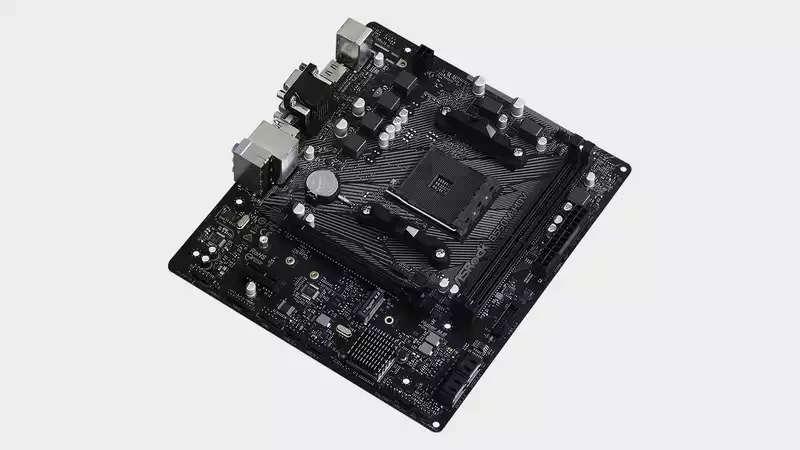When we first saw the B550, the second stage of AMD's new 500 series chipset, we saw some rather expensive boards. Then came the Asrock B550 Taichi, a $300 B550 motherboard. Perhaps everything was getting a little ridiculous. And now Asrock is back, but this time with more B550 options than we originally expected. Will it be included in our Best B550 Motherboards guide or not? Let's see.
So here we have the Asrock B550M-HDV. Clocking in at about $80, it fits rather nicely into the value-oriented B550 market positioning It's not that B550 is a bad chipset. In fact, by most measures, it is not miles away from its larger X570 sibling. The main difference between the two lies in the link between the CPU and the PCH chip, the latter being essentially a motherboard chipset; in the case of the B550, this link consists of four Gen 3 PCI Express lanes; the X570. again, quad lanes, but with Gen 4 specifications, so the bandwidth is twice double the bandwidth.
The most direct and obvious impact is on storage: with the B550 chipset, the Gen 4 link goes directly to the CPU. There are 16 lanes for graphics and an additional 4 lanes for storage, allowing support for quad-lane PCIe Gen 4 M.2 SSDs. However, while the X570 supports a second Gen 4 M.2 drive connected to the PCH chip, the B550's secondary M.2 socket is limited to PCIe Gen 3 speeds.
The slower PCH link also affects other bandwidth-sensitive functions, such as USB connectivity. However, the impact is not as great: it supports up to two USB 3.1 Gen 2 ports, which the B450 did not have. Of course, since the B550 is a new platform, it supports both AMD's latest Ryzen 3000 CPUs and upcoming processors based on the Zen 3 architecture, which will appear later this year under the Ryzen 4000 brand. In other words, it is future-proof.
If this is the general theory behind the B550, what about the specific implementation of the Asrock B550M-HDV? Without a doubt, it looks cheaper at first glance. For example, there are only two memory DIMM slots; there is only one 4-pin auxiliary CPU power socket, making it unsuitable for overclocking. Cooling is also minimal: the VRMs are bare, the power supply has four phases, and there are only two fan headers. [Other features include one USB 3.2 Gen 1 header, two USB 2.0 headers, four SATA ports, and one PCIe 3.0 x1 slot. The back panel has four USB-A 3.2 Gen 1 ports, two USB-A 2.0 sockets, LAN, PS2, HDMI, VGA, and DVI. What is not present is USB-C or DisplayPort.
Of course, the two most important features other than the AM4 CPU socket are ignored: the x16 PCIe 4.0 graphics slot and the quad-lane PCIe 4.0 M.2 port. In other words, what really matters for core PC performance exists, in theory. And it has been proven in practice: the Asrock B550M-HDV performed more than adequately against much more expensive boards in nearly every standard-clock benchmark we ran.
This includes comparisons to Asrock's own B550 Taichi board. This includes CPU performance, storage, and gaming. In fact, this budget board is faster than the megabucks Taichi in several benchmarks, but all results are within the margin of error, with no run-by-run variation. Simply put, you won't feel any difference between this board and the more expensive option when it comes to subjective computing experience.
At least, that's true at standard clock speeds. As for overclocking, well, like the Asrock Taichi, the B550M-HDV does not allow you to tweak the multiplier settings; the board automatically selects the CPU voltage. So beginners need to be careful. However, if the CPU is 1. At 3V, this board achieved exactly the same all-core 4.2GHz as almost every B550 tested with the AMD Ryzen 3100 quad-core test chip.
Thus, the immediate conclusion might be, why pay more? The answer is that the Ryzen 3100 is not a very demanding chip; overclocking a CPU with 8 cores or more is limited by inexpensive 4-phase power supply designs and minimal cooling. Of course, few existing Ryzen CPUs can actually be successfully overclocked. So that potential limitation doesn't mean much; it is possible that future AMD CPUs based on the Zen 3 architecture will offer more headroom. But that is a matter of speculation, and in any case, at this price point, it is unlikely to get the last word in overclocking prowess.
Overall, our main reservations relate to features. We would be quite happy to see at least one USB-C socket in 2020, plus a second M.2 slot, which could be added with a PCIe x1 board, although M.2 slots are limited to low-speed x1 PCIe 3.0. And that's extra money. If these lacks are a concern, perhaps it would be wise to shop around and find a board that has them as standard equipment.
.

Comments